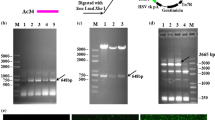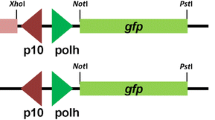Abstract
Objectives
To analyze the anti-insect mechanism of viral pesticide AcMNPV-BmK IT(P10/PH) in the host Spodoptera frugiperda 9 (Sf9) cells.
Results
Autographa californica multicapsid nucleopolyhedrovirus (AcMNPV)- mediated expression of BmK IT, regulated by P10 protein promoter (P10) and polyhedrosis promoter (PH), promoted the replication of progeny virus in host Sf9 cells. AcMNPV-BmK IT(P10) could accelerate the budding process (or speed) of budded virus (BV) in Sf9 cells. The impact of AcMNPV-BmK IT(P10) on the nuclear polymerization of filamentous actin (F-actin) participated in regulating the accelerated budding process. Unexpectedly, both AcMNPV-BmK IT(P10) and AcMNPV-BmK IT(PH) delayed the nuclear polymerization of F-actin and promoted the clearance of F-actin in the nucleus. SfP53, an important apoptosis factor, was involved in the regulation of AcMNPV-BmK IT(P10/PH) in Sf9 cells. AcMNPV-BmK IT(P10/PH) could also delay and promote the nuclear recruitment of SfP53 after 27 h post infection (h p.i.).
Conclusion
SfP53 and F-actin are the targets of viral pesticide AcMNPV-BmK IT (P10/PH) in host Sf9 cells, which provides the experimental basis for the development of recombinant baculovirus biopesticides.





Similar content being viewed by others

References
Charlton CA, Volkman LE (1991) Sequential rearrangement and nuclear polymerization of actin in baculovirus infected Spodoptera frugiperda cells. J Virol 65:1219–1227
Clem RJ (2015) Viral IAPs, then and now. Semin Cell Dev Biol 39:72–79
DiFalco MR, Bakopanos E, Patricelli M, Chan G, Congote LF (1997) The influence of various insect cell lines, p10 and polyhedron promoters in the production of secreted insulin-like growth factor–interleukin-3 chimeras in the baculovirus expression system. J Biotechnol 56:49–56
Dreschers S, Roncarati R, Knebel-Mo¨rsdor DF (2001) Actin rearrangement-inducing factor of baculoviruses is tyrosine phosphorylated and colocalizes to F-Actin at the plasma membrane. J Virol 75:3771–3778
Everly DN Jr, Kusano S, Raab-Traub N (2004) Accumulation of cytoplasmic beta-catenin and nuclear glycogen synthase kinase 3 beta in Epstein-Barr virus-infected cells. J Virol 78:11648–11655
Fan XJ, Zheng B, Fu YJ, Sun Y, Liang AH (2008) Baculovirus-mediated expression of a Chinese scorpion neurotoxin improves insecticidal efficacy. Chin Sci Bull 53:1855–1860
Fu YJ, Li X, Du J, Zheng SH, Liang AH (2015) Regulation analysis of AcMNPV-mediated expression of a Chinese scorpion neurotoxin under the IE1, P10 and PH promoter in vivo and its use as a potential bio-insecticide. Biotechnol Lett 37:1929–1936
Fu YJ, Miao YY, Zheng SH, Du J, Liang AH (2016a) AcMNPV-BmK IT improves the progeny virus production via baculovirus GP64 envelope fusion protein. Biotechnol Lett. doi:10.1007/s10529-016-2146-8
Fu YJ, Lin TT, Liang AH, Hu FY (2016b) Effects of recombinant baculovirus AcMNPV-BmK IT on the formation of early cables and nuclear polymerization of actin in Sf9 cells. Cytotechnology 68:381–387
Goley ED, Ohkawa T, Mancuso J, Woodruff JB, Alessio JAD, Cande WZ, Volkman LE, Welch MD (2006) Dynamic nuclear actin assembly by Arp2/3 complex and a baculovirus WASP-like protein. Science 314:464–467
Goudet C, Chi CW, Tytgat J (2002) An overview of toxins and genes from the venom of the Asian scorpion Buthus martensii Karsch. Toxicon 40:1239–1258
Hao CJ, Xu CG, Wang W, Chai BF, Liang AH (2005) Expression of an insect excitatory toxin, BmK IT, from the scorpion, Buthus martensii Karsch, and its biological activity. Biotechnol Lett 27:1929–1934
Katsuma S, Kawaoka S, Mita K, Shimada T (2008) Genome-wide survey for baculoviral host homologs using the Bombyx genome sequence. Insect Biochem Mol Biol 38(12):1080–1086
Lin CH, Jarvis DL (2013) Utility of temporally distinct baculovirus promoters for constitutive and baculovirus-inducible transgene expression in transformed insect cells. J Biotechnol 165:11–17
Mohammad M, Mazhar H, Leila M, Sassan A (2015) The baculovirus antiapoptotic p35 protein functions as an inhibitor of the host RNA interference antiviral response. J Virol 89:8182–8192
Peng K, Wu MZ, Deng F, Song JJ, Dong CS, Wang HL, Hu ZH (2010) Identification of protein–protein interactions of the occlusion-derived virus-associated proteins of Helicoverpa armigera nucleopoly- hedrovirus. J GenVirol 91:659–670
Sonja MB (2008) Viral subversion of apoptotic enzymes: escape from death row. Annu Rev Microbiol 62:171–192
Wang Q, Liang C, Song J, Chen X (2007) HA2 from the Helicoverpa armigera nucleopolyhedrovirus: a WASP-related protein that activates Arp2/3-induced actin filament formation. Virus Res 127:81–87
Wang Y, Wang Q, Liang C, Song J, Li N, Shi H, Chen X (2008) Autographa californica multiple nucleopolyhedrovirus nucleocapsid protein BV/ODV-C42 mediates the nuclear entry of P78/83. J Virol 82:4554–4561
Wen L, Lin Y, Zhang ZL, Lu W, Lv C, Chen ZL, Wang HZ, Pang DW (2016) Intracellular self-assembly based multi-labeling of key viral components: envelope, capsid and nucleusc acids. Biomaterials 99:24–33
Wu CX, Wang S (2012) A pH-sensitive heparin-binding sequence from Baculovirus gp64 protein is important for binding to mammalian cells but not to Sf9 insect cells. J Virol 86:484–491
Acknowledgments
This project was supported by Grants from ‘National Natural Science Foundation of China (No. 31272100 and 31372199)’, ‘Natural Science Foundation of Shanxi Province (No. 2014011038-1)’.
Supporting Information
Supplementary Table 1—Sequence of primers used to amplify vp39, polh and β-actin gene.
Author information
Authors and Affiliations
Corresponding author
Additional information
Leixi Cao and Xing Li have contributed equally to this work.
Electronic supplementary material
Below is the link to the electronic supplementary material.
Rights and permissions
About this article
Cite this article
Cao, L., Li, X., Zheng, S. et al. SfP53 and filamentous actin (F-actin) are the targets of viral pesticide AcMNPV-BmK IT (P10/PH) in host Spodoptera frugiperda 9 cells. Biotechnol Lett 38, 2059–2069 (2016). https://doi.org/10.1007/s10529-016-2201-5
Received:
Accepted:
Published:
Issue Date:
DOI: https://doi.org/10.1007/s10529-016-2201-5



